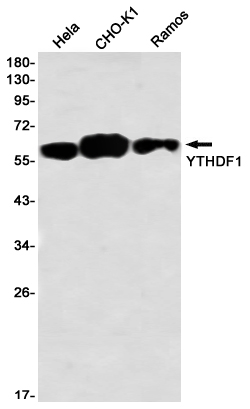
| WB | 1/500-1/1000 | Human,Hamster |
| IF | 1/20 | Human,Hamster |
| IHC | 咨询技术 | Human,Hamster |
| ICC | 技术咨询 | Human,Hamster |
| FCM | 咨询技术 | Human,Hamster |
| Elisa | 咨询技术 | Human,Hamster |
| Aliases | C20orf21; DF1 |
| Entrez GeneID | 228994 |
| WB Predicted band size | Calculated MW: 61 kDa; Observed MW: 61 kDa |
| Host/Isotype | Rabbit IgG |
| Antibody Type | Primary antibody |
| Storage | Store at 4°C short term. Aliquot and store at -20°C long term. Avoid freeze/thaw cycles. |
| Species Reactivity | Human,Hamster |
| Immunogen | Recombinant protein of mouse YTHDF1 |
| Formulation | Purified antibody in TBS with 0.05% sodium azide,0.05%BSA and 50% glycerol. |
+ +
1. **"YTHDF1 links hypoxia adaptation and non-small cell lung cancer progression"**
- **作者**: Li et al.
- **摘要**: 研究利用YTHDF1抗体揭示YTHDF1通过促进缺氧诱导因子(HIF)相关mRNA的翻译驱动非小细胞肺癌的进展,为靶向YTHDF1的癌症治疗提供依据。
2. **"N6-methyladenosine modulates messenger RNA translation efficiency"**
- **作者**: Wang et al.
- **摘要**: 通过YTHDF1抗体实验证明,YTHDF1识别m6A修饰并加速靶标mRNA的翻译效率,揭示了其在蛋白质合成调控中的核心作用。
3. **"YTHDF1 regulates synaptic plasticity and memory via translational control of MK2"**
- **作者**: Shi et al.
- **摘要**: 使用YTHDF1抗体敲除小鼠模型,发现YTHDF1通过调控突触相关mRNA的翻译影响海马区突触可塑性及长期记忆形成。
4. **"Dynamic m6A modification regulates viral RNA recognition by YTHDF1"**
- **作者**: Zhou et al.
- **摘要**: 研究通过免疫共沉淀(Co-IP)结合YTHDF1抗体,阐明病毒RNA的m6A修饰动态变化如何影响YTHDF1介导的宿主抗病毒免疫反应。
The YTHDF1 antibody is a crucial tool in studying the functional role of YTHDF1. a member of the YTH domain-containing family of proteins that recognize N6-methyladenosine (m6A), the most prevalent internal RNA modification in eukaryotes. YTHDF1 is an m6A "reader" protein that binds m6A-modified mRNAs to regulate their stability, localization, and translation. Structurally, it contains a conserved YTH domain at its C-terminus for m6A recognition and disordered regions at the N-terminus that mediate interactions with translation machinery and stress granules.
Research using YTHDF1 antibodies has revealed its involvement in diverse physiological and pathological processes, including neurodevelopment, immune response, and cancer progression. In cancer, YTHDF1 is often overexpressed and linked to tumor growth, metastasis, and therapy resistance by enhancing the translation of oncogenic mRNAs. The antibody enables detection of YTHDF1 expression levels via techniques like Western blot, immunohistochemistry, and immunofluorescence, aiding in biomarker studies. It also facilitates functional studies, such as co-immunoprecipitation to identify YTHDF1-associated RNA-protein complexes.
Commercial YTHDF1 antibodies are typically raised against specific epitopes (e.g., human YTHDF1 residues 350-450) and validated for species reactivity (human, mouse, rat). Proper validation with knockout controls is essential due to potential cross-reactivity with paralogs like YTHDF2/3. These reagents continue to advance our understanding of epitranscriptomic regulation in diseases and therapeutic targeting.
×